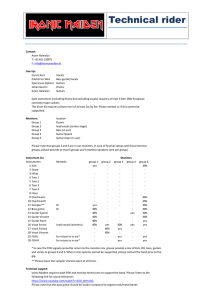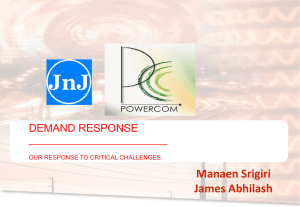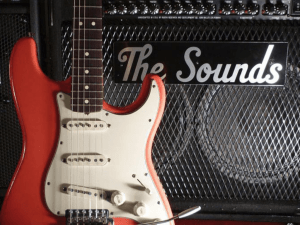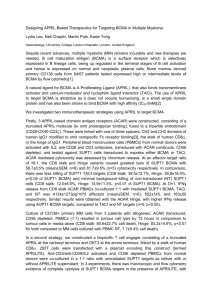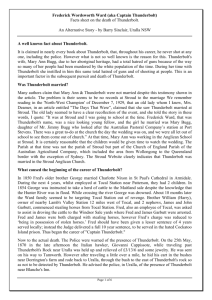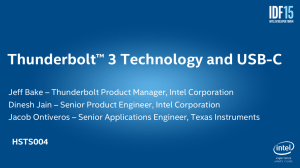Description
advertisement
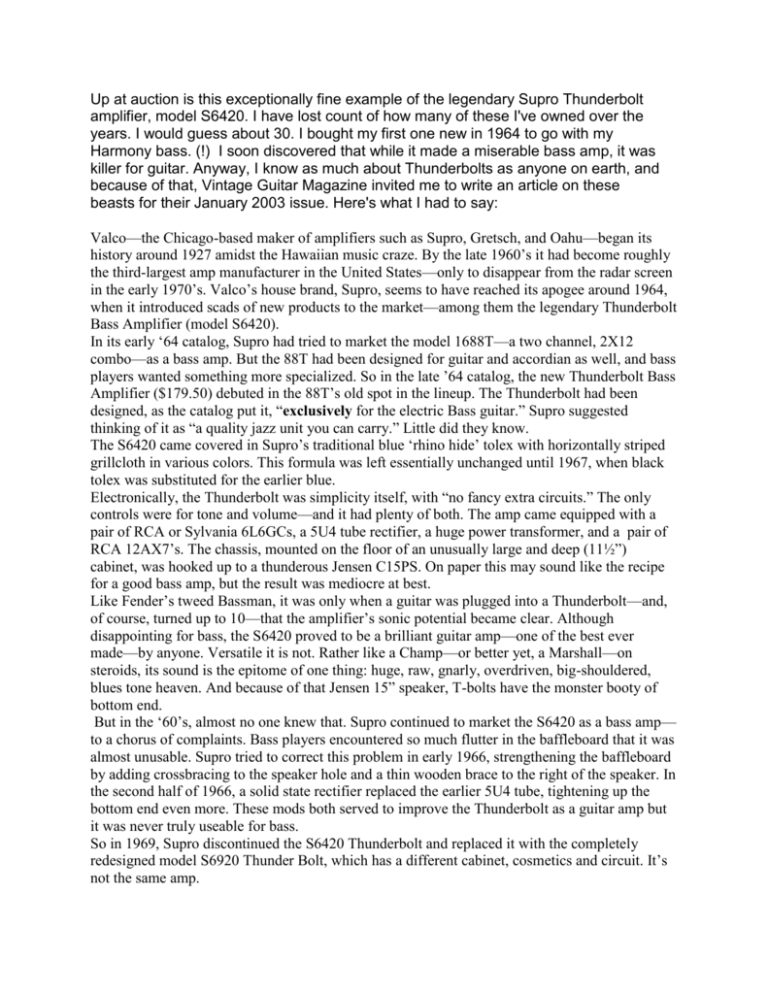
Up at auction is this exceptionally fine example of the legendary Supro Thunderbolt amplifier, model S6420. I have lost count of how many of these I've owned over the years. I would guess about 30. I bought my first one new in 1964 to go with my Harmony bass. (!) I soon discovered that while it made a miserable bass amp, it was killer for guitar. Anyway, I know as much about Thunderbolts as anyone on earth, and because of that, Vintage Guitar Magazine invited me to write an article on these beasts for their January 2003 issue. Here's what I had to say: Valco—the Chicago-based maker of amplifiers such as Supro, Gretsch, and Oahu—began its history around 1927 amidst the Hawaiian music craze. By the late 1960’s it had become roughly the third-largest amp manufacturer in the United States—only to disappear from the radar screen in the early 1970’s. Valco’s house brand, Supro, seems to have reached its apogee around 1964, when it introduced scads of new products to the market—among them the legendary Thunderbolt Bass Amplifier (model S6420). In its early ‘64 catalog, Supro had tried to market the model 1688T—a two channel, 2X12 combo—as a bass amp. But the 88T had been designed for guitar and accordian as well, and bass players wanted something more specialized. So in the late ’64 catalog, the new Thunderbolt Bass Amplifier ($179.50) debuted in the 88T’s old spot in the lineup. The Thunderbolt had been designed, as the catalog put it, “exclusively for the electric Bass guitar.” Supro suggested thinking of it as “a quality jazz unit you can carry.” Little did they know. The S6420 came covered in Supro’s traditional blue ‘rhino hide’ tolex with horizontally striped grillcloth in various colors. This formula was left essentially unchanged until 1967, when black tolex was substituted for the earlier blue. Electronically, the Thunderbolt was simplicity itself, with “no fancy extra circuits.” The only controls were for tone and volume—and it had plenty of both. The amp came equipped with a pair of RCA or Sylvania 6L6GCs, a 5U4 tube rectifier, a huge power transformer, and a pair of RCA 12AX7’s. The chassis, mounted on the floor of an unusually large and deep (11½”) cabinet, was hooked up to a thunderous Jensen C15PS. On paper this may sound like the recipe for a good bass amp, but the result was mediocre at best. Like Fender’s tweed Bassman, it was only when a guitar was plugged into a Thunderbolt—and, of course, turned up to 10—that the amplifier’s sonic potential became clear. Although disappointing for bass, the S6420 proved to be a brilliant guitar amp—one of the best ever made—by anyone. Versatile it is not. Rather like a Champ—or better yet, a Marshall—on steroids, its sound is the epitome of one thing: huge, raw, gnarly, overdriven, big-shouldered, blues tone heaven. And because of that Jensen 15” speaker, T-bolts have the monster booty of bottom end. But in the ‘60’s, almost no one knew that. Supro continued to market the S6420 as a bass amp— to a chorus of complaints. Bass players encountered so much flutter in the baffleboard that it was almost unusable. Supro tried to correct this problem in early 1966, strengthening the baffleboard by adding crossbracing to the speaker hole and a thin wooden brace to the right of the speaker. In the second half of 1966, a solid state rectifier replaced the earlier 5U4 tube, tightening up the bottom end even more. These mods both served to improve the Thunderbolt as a guitar amp but it was never truly useable for bass. So in 1969, Supro discontinued the S6420 Thunderbolt and replaced it with the completely redesigned model S6920 Thunder Bolt, which has a different cabinet, cosmetics and circuit. It’s not the same amp. Jimi Hendrix owned a S6420 Thunderbolt that was given away in a promotion by Guitar Player years ago. Jimmy Page has stated that he used Supro amps for recording much of the early Zep material. Whether or not he used a Thunderbolt is unclear, but from his playing on “Heartbreaker,” it sounds like he did. I only kept two Thunderbolts out of the huge stack of them that once occupied my living room wall and this is one of the two. I know that I said in the article that the solid state rectifier model is preferable to the tube rectifier. I've changed my mind, or at least I think the whole debate is just another variation on whether you like tube rectifiers or solid state rectifiers better. To me the tube rectifier model --which this one is-- sounds more organic and authentically bluesy and the solid state model a bit brighter and more metallic. Both models sound really wonderful -- IF you can find a great one. That can take a while (not to mention money) because Supro's quality control was very lax and all of them that I've owned have been somewhat different. Some of them stunk, frankly. Actually about half of them. One even stunk literally! I think someone had kept it in a barn... ahh, war stories from my days as a Supro collector... Anyway, this one sounds superb -- exactly like a Thunderbolt should sound and as fine as the best I've ever owned. I remember seeing a Thunderbolt sell on eBay for $2700. I can guarantee you that this amp sounds as good or better than that one. You won't find one that sounds better than this. They just don't sound any better than this one. I would guess that this is an early '66 because it has the brace on the baffle board that Valco added at that time. Cosmetic condition report: Virtually all original except the cord has been replaced and it now has a three-way plug. The 15" Jensen speaker is the original (you can see it has a 1965 date code), the rhino hyde tolex is basically perfect except for a tiny loss on the lower right front corner, the grill cloth is basically perfect (no rips, stains, holes) except for a little light fraying, that's about it. You can supersize the photos and examine it yourself. The logo is not broken, the knobs are original, there is VIRTUALLY NO CORROSION to speak of anywhere, and boy is that RARE, the speaker has its original cone and could not sound better, oh, boy. Nicely tubed (another reason it sounds so good), it has a matched pair of vintage Sylvania 6L6's, I think everything else is RCA. Berlieve it or not, you can play some very nice jazz on this amp but Thunderbolts were really born to rock in the Led Zep, Hendrix style. (Hendrix's Thunderbolt was given away in a Guitar Player promotion years ago.) It's the sort of amp that really sounds best cranked at about 8 1/2 with the tone turned up about the same. Brutal screaming distortion, sounds like it is about to blow up. And that's just plug in and play, no pedals required.



